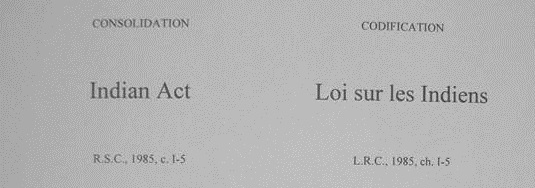Colonialism is the process through which a foreign people establish control over a territory and, if applicable, its Indigenous peoples. Control is established through various means, including political or economic legislation directed at Indigenous peoples or their lands, foreign settlement, and assimilation of Indigenous peoples into the colonizer’s culture. While colonialism in different forms is a defining mark of the history of many countries, colonialism in Canada began in earnest with French settlement at Quebec in 1608. The history of the second colonial power to influence Canada, the British, began in 1670 when the Crown issued a Royal Charter to the Hudson’s Bay Company.
French Colonialism in Canada
French colonial activity in Canada began as early as the 16th century. Jacques Cartier planted a cross at Gaspé, Quebec in 1534, claiming the land in the name of the king of France. However, it was not until 1608, when Samuel de Champlain founded Quebec, that France established a long-term permanent presence. An early attempt at settlement at Port Royal in 1605 failed by 1607 (see Port-Royal National Historic Site). In the years that followed, the French established a colonial environment in various ways. These included immigration, surveying seigneuries for French settlement, implementing French civil law, establishing the Catholic Church, and implementing policies and practices directed at Indigenous peoples. The founding of New France was based on the Doctrine of Discovery and the notion of terra nullius.

Trade companies from across France undertook early colonial administration in New France. These companies aimed to populate territory claimed by France for economic purposes. During this time, Catholic orders established missions to convert Indigenous peoples, such as the Sainte-Marie Among the Huron mission.
Following the failure of the trade companies in maintaining the colony, the king of France established New France as a province of France. The French government took over administrative control in 1663. One aspect of the French government’s increased control was the deployment of the Carignan-Salières Regiment. This regiment enforced the will of the king of France in the territory. These efforts included the migration of approximately 800 young women from France to increase the colony’s French population and support its self-perpetuation (see Filles du roi).
French officials sought to create a homogenous population. In the words of one French official, “we would like to see only one people in all the land.” France also hoped Indigenous peoples would seek a closer relationship with them. They believed Indigenous peoples would become “civilized” if they were converted to Catholicism. French policies in the 17th century aimed for assimilation — the incorporation of Indigenous people into the colony through conversion, education and intermarriage. This led Récollets, a French religious order, to open a boarding school for Indigenous children in 1620. Other Catholic orders followed. School administrators hoped that Indigenous children, upon leaving these institutions, would act as colonial agents in their communities. The seminaries and boarding schools of 17th century New France were a prelude to the British-Canadian establishment of the Indian residential school system. New France also created reserves or mission settlements for Indigenous people (see also Missions and Missionaries). For example, settlements at Sillery, Odanak, Bécancour, Akwesasne, Kanesatake and Kahnawake were meant to teach Christian values and French culture to Indigenous people. Overall, French administrators believed that assimilation would strengthen the colony.
British Colonialism in Canada
British colonialism in Canada began in 1670. At this time, the Crown issued a Royal Charter to the Hudson’s Bay Company, granting it legal and trading rights to all the lands that drained into Hudson Bay. This vast area became known as Rupert’s Land, which included portions of current Quebec, Ontario, Manitoba, Saskatchewan, Alberta and Nunavut.
Britain, with the capture of Quebec and Montreal in 1760, began occupying French forts in the interior. Following the Seven Years’ War, Britain gained control of French claims to North America through the 1763 Treaty of Paris. That same year, King George III issued the Royal Proclamation of 1763. The Proclamation established the basis for governing the North American territories. In addition, it acknowledged Indigenous peoples’ right to hunt on land not ceded to the Crown, and reserved land outside the boundaries of the British colonies for Indigenous peoples. As sovereign of this territory, however, the king claimed ultimate “dominion” over the entire region. The Proclamation also protected Indigenous land from settler purchase, requiring that it first be sold or ceded to the Crown.
After 1783, with the influx of thousands of Loyalist refugees, British Canada continued to create colonial policies through the creation of New Brunswick in 1784 and Upper Canada in 1791. In Nova Scotia, for example, a high ranking British official claimed that First Nations were a “helpless race.” This sentiment played a role in the creation of the Act to Provide for the Instruction and Permanent Settlement of the Indians in 1842. The Act dealt with Indigenous education, poor relief, agriculture, permanent settlement and surveying for both the protection and sale of Indian lands. Legislation passed by the colonies also served to restrict and reduce First Nations people. For example, New Brunswick passed the Act to regulate the Management and Disposal of the Indian Reserves in this Province in 1844. This legislation led to massive land loss in 1844. Other colonies also sought control of what lands remained in Indigenous hands.
In Upper Canada, policies involved signing treaties to access land for settlement or resource exploitation while creating reserves. The first treaties to stipulate the creation of reserves in Upper Canada were signed in the 1850s (see Reserves in Ontario). In 1850, Lower Canada created an Act for the better protection of the Lands and Property of the Indians in Lower Canada. This Act was passed as Lower Canada created Indian reserves in the Ottawa Valley, such as Kitigan Zibi (see also Reserves in Quebec). This process removed First Nations from the land, settled them in a permanent community and opened the “free” land for French Canadian loggers. The Act also created the first definition of an Indian in legislation in the Canadas. Soon after this, Upper Canada passed the Gradual Civilization Act in 1857, which also contributed to the definition of Indian. The Gradual Civilization Act aimed to assimilate Indigenous peoples by promoting enfranchisement, Christianization and acceptance of European ideals of private land ownership and accumulation of wealth. Indigenous people who had no debt, were considered educated, and who the colonial government considered of “good moral character,” were able to apply for a land grant from the government. The Act shows the underlying approach of colonial policies that aimed to discourage Indigenous peoples from presenting and maintaining their social and cultural practices, identity and ideals, while granting settlers access to lands and resources at the expense of Indigenous peoples.
In the late 1700s, religious orders renewed efforts to assimilate Indigenous children through day and boarding schools (see also Indian Day Schools in Canada; Residential Schools in Canada). These efforts at assimilation continued, ultimately forming the basis for Canada’s residential school system that lasted from the 1830s until 1996. The intent of these residential schools was to assimilate Indigenous children through a Christian education while isolating them from the influences of the reserves. Graduates were expected to either merge into mainstream society or return to their communities to act as harbingers of change.
Effects of Colonialism on Indigenous Peoples

When the Dominion of Canada formed in 1867, many policies, such as residential schools, continued. Other policies the Government of Canada created were similar to those enacted by the British Crown and its colonies. The Indian Act of 1876 reinforced and legitimated the domination of Indigenous peoples and lands. It has given the Crown control over nearly every aspect of Indigenous peoples’ lives and has worked towards assimilation and removal through systems like residential schools and bans on ceremonies, such as the Potlatch ban.
Did You Know?
In 2007, a study by the Canadian Senate recognized that alienation from land created economic marginalization experienced by Indigenous peoples, which further contributed to lack of food security and education, high levels of poverty, unemployment, poor housing, homelessness and migration from home communities.
Regardless of intent, treaties have reduced Indigenous land holding for the benefit of the state, its settlers and corporations. The government created a reserve system that, when combined with racism and Indian policies, has led to poverty, ill health, violence and other forms of individual, familial and societal dysfunction. On top of this, resource extraction has led to contamination of soil and water, which has further eroded Indigenous sovereignty, culture and their right to self-determination.

 Share on Facebook
Share on Facebook Share on X
Share on X Share by Email
Share by Email Share on Google Classroom
Share on Google Classroom




